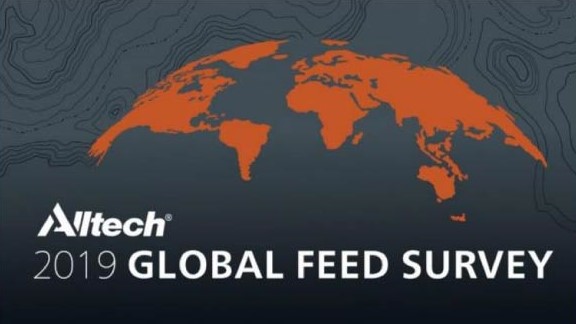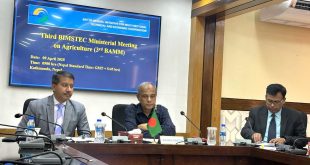
[LEXINGTON, Ky.] – The2019 Alltech Global Feed Survey, released today, estimates that international feed tonnage has increased by a strong 3 percent to 1.103 billion metric tons of feed produced in 2018, exceeding 1 billion metric tons for the third consecutive year. The eighth edition of the annual survey includes data from 144 countries and nearly 30,000 feed mills. The feed industry has seen 14.6 percent growth over the past five years, equating to an average of 2.76 percent per annum. As the population grows, so does the middle class, which is well reflected in an increase in overall protein consumption.
The top eight countries are China, the U.S.,Brazil, Russia, India, Mexico, Spain and Turkey. Together, they produce 55 percent of the world’s feed production and contain 59 percent of the world’s feed mills, and they can be viewed as an indicator of the trends in agriculture. Predominant growth came from the layer, broiler and dairy feed sectors.
“Alltech works together with feed mills, industry and government entities around the world to compile data and insights to provide an assessment of feed production each year,” said Dr. Mark Lyons, president and CEO of Alltech. “We are proud to present the eighth annual Alltech Global Feed Survey and share the results publicly to demonstrate the importance of the animal feed industry as we strive to provide for a planet of plenty.”
The Alltech Global Feed Survey assesses compound feed production and prices through information collected by Alltech’s global sales team and in partnership with local feed associations in the last quarter of 2018. It is an estimate and is intended to serve as an information resource for policymakers, decision-makers and industry stakeholders.
Regional results from the 2019 Alltech Global Feed Survey
- North America: North America saw steady growth of 2 percent over last year due to an increase in the major species, with beef and broilers leading the growth at 3 percent each. The U.S. remained the second-largest feed-producing country globally, behind China. Feed prices in North America are the lowest globally across all species, and with the availability of land, water and other resources, the region is expected to remain a primary contributor to feed production.
- Latin America: As a region, Latin America was relatively stagnant this year. Brazil remained the leader in feed production for the region and third overall globally. Brazil, Mexico and Argentina continue to produce the majority of feed in Latin America, with 76 percent of regional feed production. Brazil stayed flat, while Mexico and Argentina saw growth of 1 percent and 4 percent, respectively. Colombia’s feed production grew by approximately 8 percent, primarily due to an increase in pork and egg production. Several countries saw a decline in feed production, such as Venezuela (-27 percent), El Salvador (-16 percent) and Chile (-8 percent).
- Europe: Europe saw an overall growth of about 4 percent over last year, making it the second-fastest-growing region in the survey, resulting from feed production increases in layer (7 percent), broiler (5 percent), aquaculture (5 percent), dairy (4 percent) and pig (3 percent). Beef was the only primary protein species to decline, though it was less than 1 percent.
Much of the region’s growth can be attributed to smaller countries, such as Turkmenistan, Macedonia, Azerbaijan, Montenegro, Kazakhstan and Uzbekistan, which all saw increases in overall production estimates of 20 percent or more. Additionally, larger-producing countries like Russia, Spain and Turkey saw strong increases in feed production estimates, which added to the overall production growth.
- Asia-Pacific: The Asia-Pacific region is home to several of the top 10 feed-producing countries, including China, India and Japan, and accounted for more than 36 percent of the world’s feed tonnage. China maintained status as the top feed-producing country in the world with 187.89 million metric tons, with 10 million metric tons more than the U.S. Increased production for Asia-Pacific came from India with 13 percent due to growth in dairy, layer and broiler feeds. Other countries that demonstrated higher growth variance included Pakistan, Myanmar and Laos. Southeast Asia’s feed production represented over 20 percent of the Asia-Pacific region’s feed production, with Indonesia, Vietnam, the Philippines and Thailand contributing to 93 percent of Southeast Asia’s feed production.
- Africa: Africa continued strong growth with a 5 percent increase in overall feed production, and no country in the region saw a decline. Morocco demonstrated strong growth across dairy, beef, layers, broilers and turkeys. The areas that declined for feed production was equine (-4 percent) and pets (-14 percent). These two areas represent a very small proportion of Africa’s overall production, so the impact is very minimal. Most of the major animal production species in ruminant and poultry contributed to the overall growth of the region.
Notable species results from the 2019 Alltech Global Feed Survey
- In the poultry industry, major growth areas for layer feed included Europe, Latin America and Asia-Pacific. In Europe, Poland and Uzbekistan each saw growth of around 200,000 metric tons. Latin America had increases in Colombia, Peru, Brazil and Mexico. In the Asia-Pacific region, South Korea, India and Indonesia all saw growth of several hundred metric tons. North America experienced overall growth of 2 percent, in which both the U.S. and Canada saw increased production. Africa saw a small decrease in layer production due to declines in both Egypt and Seychelles.
Globally, broiler production increased by approximately 3 percent in 2018. There was growth in all regions, except for Latin America, in which a very small decline was observed. Africa showed 9 percent growth, demonstrating an overall trend that as populations grow and become wealthier, interest in protein — particularly in palatable chicken — does as well.
- Pig feed production saw an increase of nearly 1 percent in 2018. The primary producing region for pig feed is Asia-Pacific, but this was also the only region that saw a decline in pig feed production as Mongolia, Vietnam, China, New Zealand and Japan experienced decreases. From a tonnage standpoint, Europe saw the largest growth at approximately 2.2 million metric tons. Russia and Spain accounted for the majority, while Finland, Denmark, France and Poland also contributed. Latin America saw the greatest growth in pig feed as a percentage at 5 percent, with the largest growth seen in Mexico and Argentina.
- Global dairy feed production saw growth in North American, Europe and Africa, while Latin America remained flat. Europe, a global leader in dairy production, grew on average by approximately 4 percent. The largest increase was in Turkey with 10 percent, while Ireland, Russia and the U.K. also contributed to the region’s growth. Africa’s growth was primarily due to a significant increase in both Morocco and Nigeria.
- North America has always led beef feed production and continues to do so with an increase of 3 percent in 2018. Europe saw a small decline at barely 1 percent and remained in second place. Latin America saw strong growth of approximately 8 percent, with Mexico and Argentina as the primary contributors. As a result, the Latin American region has taken third place in beef feed production, moving ahead of the Asia-Pacific region. China and Australia both saw growth in the Asia-Pacific region but could not offset the overall decline in countries such as Bangladesh, Mongolia, Indonesia, Taiwan, Vietnam and Pakistan.
- Overall, aquaculture feeds showed growth of 4 percent over last year. This was primarily attributed to strong increases in the Asia-Pacific and European regions. The traditional Asia-Pacific leaders in aquaculture, Vietnam, India and Indonesia, combined for an additional 1.58 million metric tons of feed in the region. China, the region’s leader, also saw an increase of 1 percent over last year. The primary European leaders either experienced strong growth or remained relatively flat. Those that did grow included Norway and Turkey, both at 7 percent, and Spain at a substantial 31 percent. The other regions remained relatively flat or saw only a 1 percent increase or decrease in feed production, demonstrating the continuity of the industry as a whole.
- The pet food sector saw growth of approximately 1 percent, primarily attributed to an increase in the Asia-Pacific region, which was offset by a decrease in the Latin American and African regions. North America and the Middle East both remained relatively flat. In previous surveys, Europe had been the top-producing region for pet food production, but after a reassessment of 2017 numbers and despite growth of 2 percent, it ranks just behind North America. Europe is estimated in 2018 to have produced 8.6 million metric tons in total, approximately 200,000 behind North America. Africa saw a small decrease in production, but the actual tonnage is quite small compared to many of the other regions. The Latin American region experienced a decrease of about 5 percent, which was spread across several countries, including Chile, Venezuela, El Salvador, Colombia, Argentina and Ecuador.
To access more data and insights from the 2019 Alltech Global Feed Survey, including the results booklet, an interactive global map and a pre-recorded video presentation of the results by Dr. Mark Lyons, please visit alltechfeedsurvey.com.
About Alltech:
Founded in 1980 by Irish entrepreneur and scientist Dr. Pearse Lyons, Alltech discovers and delivers solutions for the sustainable nutrition of plants, animals and people. With expertise in yeast fermentation, solid state fermentation and the science of nutrigenomics, Alltech is a leading producer and processor of yeast additives, organic trace minerals, feed ingredients, premix and feed.
Our guiding ACE principle seeks to develop solutions that are safe for the Animal, Consumer and the Environment. Our more than 6,000 talented team members worldwide put this purpose to work every day for our customers.
Alltech is a family-owned company, which allows us to adapt quickly to emerging customer needs and to stay focused on advanced innovation. Headquartered just outside of Lexington, Kentucky, USA, Alltech has a strong presence in all regions of the world. For further information, visit www.alltech.com/news. Join us in conversation on Facebook, Twitter and LinkedIn.
 Agrinews24 কৃষির সাথে, কৃষকের পাশে
Agrinews24 কৃষির সাথে, কৃষকের পাশে





















